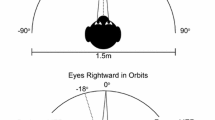Summary
Saccade characteristics have been studied during coordinated eyehead movements in monkeys. Amplitude, duration, and peak velocity of saccades with head turning were compared with saccades executed while the head was artificially restrained. The results indicate that the saccade characteristics are modulated as a function of head movement, hence the gaze movement (eye+head) exactly matches saccades with head fixed. Saccade modulation is achieved by way of negative vestibulo-ocular feedback. The neck proprioceptors, because of their longer latency, are effective only if the head starts moving prior to the onset of saccade. It is concluded that saccades made with head turning are not “ballistic” movements because their trajectory is not entirely predetermined by a central command.
Similar content being viewed by others
References
Arbib, M.A.: How we know universals: retrospect and prospect. Math. Biosci. 11, 95–107 (1971).
Bartz, A.E.: Eye and head movements in peripheral vision: nature of compensatory eye movements. Science 152, 1644–1645 (1966).
Bizzi, E., Kalil, R.E., Tagliasco, V.: Eye-head coordination in monkeys: evidence for centrally patterned organization. Science 173, 452–454 (1971).
Bond, H.W., Ho, P.: Solid miniature silver-silver chloride electrodes for chronic implantation. Electroenceph. clin. Neurophysiol. 28, 206–208 (1970).
Dichgans, J., Bizzi, E., Morasso, P., Tagliasco, V.: In preparation.
—, Schmidt, C.L., Wist, E.R.: Frequency modulation of afferent and efferent unit activity in the vestibular nerve by oculomotor impulses. In: A. Brodal and O. Pompeiano (Eds.). Progress in Brain Research, 37, Basic Aspects of Central Vestibular Mechanisms. Amsterdam: Elsevier 1972.
Fleming, D.G., Vossius, G.W., Bowman, G., Johnson, E.L.: Adaptive properties of the eyetracking system as revealed by moving-head and open-loop studies. Ann. N.Y, Acad. Sci. 156, 825–850 (1969).
Meiry, J.L.: Vestibular and proprioceptive stabilization of eye movement. In: P. Bach-y Rita, C.C. Collins and J.E. Hyde (Eds.). The Control of Eye Movements. New York-London: Academic Press 1971.
Morasso, P., Graham, J.: Problems of data collection, reduction, and analysis in a neurophysiological laboratory. Proceedings of the First Bioengineering Meeting, Milano, June, 1972.
Precht, W.: Vestibular and cerebellar control of oculomotor functions. In: J. Dichgans and E. Bizzi (Eds.). Cerebral Control of Eye Movements and Motion Perception. Basel: Karger 1972.
Robinson, D.: Eye movement control in primates. Science 161, 1219–1224 (1968).
Szentágothai, J.: Pathways and synaptic articulation patterns connecting vestibular receptors and oculomotor nuclei. In: M.B. Bender (Ed.). The Oculomotor System. New York-Evanston-London: Harper and Row 1964.
Sugie, M., Wakakuwa, M.: Visual tracking with active head rotation. IEEE Trans. on System Science and Cybernetics, SSC 6, 103–109 (1970).
Author information
Authors and Affiliations
Rights and permissions
About this article
Cite this article
Morasso, P., Bizzi, E. & Dichgans, J. Adjustment of saccade characteristics during head movements. Exp Brain Res 16, 492–500 (1973). https://doi.org/10.1007/BF00234475
Received:
Published:
Issue Date:
DOI: https://doi.org/10.1007/BF00234475




